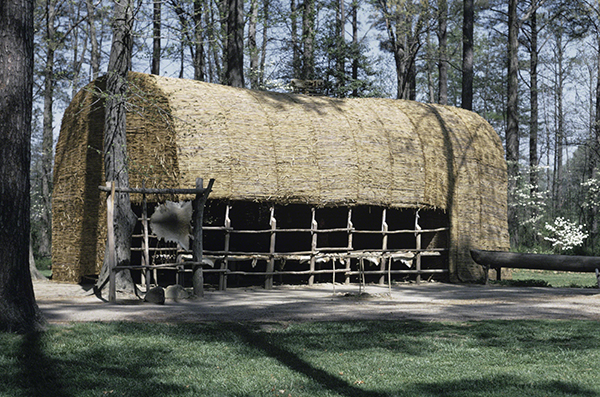Native American Heritage Month: The Powhatan Confederacy
Indigenous peoples lived in every region of present-day United States when the first Europeans arrived in the 1500s. The Spanish came via Mexico during expeditions in 1539 to 1543, 1540 to 1542, and 1581 to 1582. The British tried their hand at colonies in the 1580s in the area of present-day North Carolina. These early attempts at settlement established a history of armed conflict, relocation, and broken promises.
 |
| Powhatan Confederacy, Chief Powhatan’s (Wahunsenacawh’s) Lodge, reconstruction, near Jamestown, Virginia, original ca. early 1600s. Image © 2022 Davis Art Images. (8S-25588) |
The Powhatan Confederacy was an alliance of more than thirty Algonquian-speaking indigenous groups in the Tidewater area of Virginia. The confederacy united under Wahunsenacawh (ca. 1545–1618), commonly called Chief Powhatan. Different cultural groups that made up the confederacy had their own villages, in which women made lodges from sapling frames covered by reed mats or bark. Each group was led by a werowance, or chief, who inherited their positions through the female side of the family.
When British colonists arrived in coastal Virginia during the spring of 1607, there were around 15,000 Powhatans living in the area. Their society included a hierarchy of rulers, great warriors, priests, and commoners. As in other regions of precolonial America, status was attained through deeds in battle.
Powhatan men hunted deer and fished, and women farmed corn, beans, and squash, half of the Powhatan diet. They had an extensive trade network with other coastal cultures. After the British arrived, the Powhatan traded food and fur for British metal tools, glass, and trinkets.
As the British expanded their settlements, the Powhatan were pushed inland, away from the fertile river valleys where they hunted and fished. They also fell victim to British diseases and warfare, causing population levels to dwindle greatly. However, they adapted to their circumstances and maintained a cultural pride that carries on in their descendants to the present day.
Correlations to Davis programs: Explorations in Art 2E Grade 1: 2.8; Explorations in Art 2E Grade 2: 6.3; Explorations in Art 2E Grade 4: 3.7, 3.8; A Community Connection 2E: 1.4; Discovering Art History 4E: 4.10


Comments